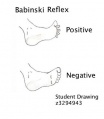File:The Babinski Reflex.jpg
The_Babinski_Reflex.jpg (386 × 443 pixels, file size: 25 KB, MIME type: image/jpeg)
The Babinski reflex is commonly seen in Friedreich's Ataxia patients.
Positive : A positive Babinski reflex is defined by flexion of the big toe, towards the body, and abduction (movement away from the midline) of the remaining four toes.
Negative : A negative Babinski reflex involves all of the toes curling forward.
Illustrated by student: z3294943
- Note - This image was originally uploaded as part of a student project and may contain inaccuracies in either description or acknowledgements. Students have been advised in writing concerning the reuse of content and may accidentally have misunderstood the original terms of use. If image reuse on this non-commercial educational site infringes your existing copyright, please contact the site editor for immediate removal.
Cite this page: Hill, M.A. (2024, June 26) Embryology The Babinski Reflex.jpg. Retrieved from https://embryology.med.unsw.edu.au/embryology/index.php/File:The_Babinski_Reflex.jpg
- © Dr Mark Hill 2024, UNSW Embryology ISBN: 978 0 7334 2609 4 - UNSW CRICOS Provider Code No. 00098G
File history
Yi efo/eka'e gwa ebo wo le nyangagi wuncin ye kamina wunga tinya nan
| Gwalagizhi | Nyangagi | Dimensions | User | Comment | |
|---|---|---|---|---|---|
| current | 16:21, 10 September 2011 |  | 386 × 443 (25 KB) | Z3294943 (talk | contribs) | The Babinski reflex is commonly seen and Friedreich's Ataxia patients. A positive Babinski reflex is defined by flexion of the big toe, towards the body, and abduction (movement away from the midline) of the other 4 toes. A negative Babinski reflex invol |
You cannot overwrite this file.
File usage
The following 3 pages use this file:
